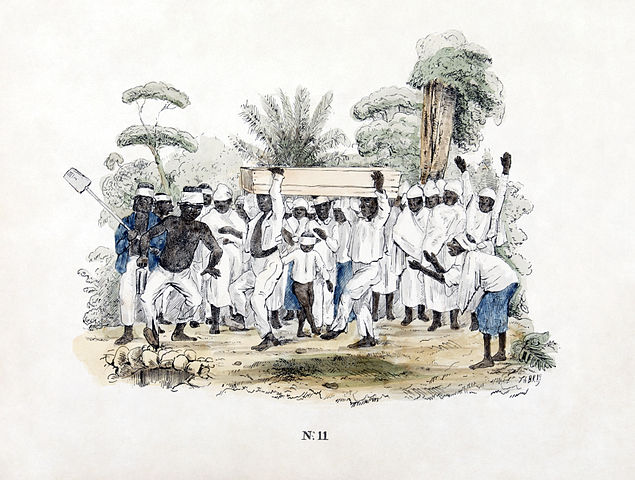 |
This is a file from the Wikimedia Commons. Information from its description page there is shown below.
Commons is a freely licensed media file repository. You can help.
|
 |
This is a featured picture, which means that members of the community have identified it as one of the finest images on the English Wikipedia, adding significantly to its accompanying article. If you have a different image of similar quality, be sure to upload it using the proper free license tag, add it to a relevant article, and nominate it. |
 |
This image was selected as picture of the day on the English Wikipedia for September 14, 2011. |
Summary
| Description |
English: Slave funeral at plantation, Suriname. Colored litho Th. Bray. Apparently the artist witnessed a burial among slaves. Slaves could arrange their own burials and perform the rituals that are part of it. From the posture of some of the persons one can see the dynamics that are part of it: people clap, move their arms, and dance. All people are dressed in white. The dead person lies in a wooden coffin, carried to the burial by two men. A little boy is blindfolded, a practice that occurred frequently. Suriname origins are from Javanese, in Java the purpose of this ritual is to deduct family grief. In this picture,the boy maybe is the only grieving family. The white clothes, describe that in Suriname still bring their beliefs (Javanese muslim)
Français : Funérailles d'un esclave dans une plantation du Surinam. Lithographie en couleurs de Th. Bray. Apparement, l'artiste a été témoin d'un enterrement d'esclave. Les esclaves pouvaient organiser les enterrements et participer aux rituels associés. La posture des personnages montre la dinamique de la cérémonie: Les gens, tous habillés de blanc, dansent et tapent dans les mains. La personne décédée repose dans un cerceuil de bois, porté par deux hommes vers la tombe. Un petit enfant a les yeux bandés, une pratique courante, mais dont la signification est inconnue.
Nederlands: Litho. Ingekleurde litho naar Th. Bray (no. 11). Kennelijk was de tekenaar getuige van een begrafenis onder slaven. Slaven konden zelf hun begrafenissen regelen en rituelen uitvoeren die daarbij hoorden. Aan de houding van enkele personen zie je de dynamiek die daarmee gepaard ging: men klapt, beweegt met de armen en danst. Hier zijn alle mensen in wit gekleed. De dode ligt in een houten kist, die naar het graf gedragen wordt door twee mannen. Een kleine jongen is geblinddoekt, een gebruik dat vaker voorkwam, maar waartoe de reden vooralsnog onbekend is.. Begrafenis bij plantageslaven
|
| Date |
1840 -1850 |
| Source |
Tropenmuseum |
| Author |
Théodore Bray (1818-1887) |
Licensing
 |
This file was provided to Wikimedia Commons by the Tropenmuseum as part of a cooperation project. The Tropenmuseum, part of the Royal Tropical Institute, exclusively provides images that are either made by its own staff, or that are otherwise free of copyright.
العربية | dansk | Deutsch | English | español | français | magyar | Bahasa Indonesia | italiano | македонски | മലയാളം | Plattdüütsch | Nederlands | polski | português | русский | +/−
|
File usage
The following pages on Schools Wikipedia link to this image (list may be incomplete):
This file contains additional information, probably added from the digital camera or scanner used to create or digitize it. If the file has been modified from its original state, some details may not fully reflect the modified file.
Wikipedia for Schools brings Wikipedia into the classroom. SOS Childrens Villages believes education is an important part of a child's life. That's why we ensure they receive nursery care as well as high-quality primary and secondary education. When they leave school, we support the children in our care as they progress to vocational training or higher education. You can help by sponsoring a child.



